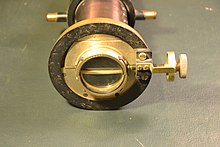Heliometer


The Heliometer is a historical measurement instrument of astronomy for the precise measurement of very small angle . It was initially intended for the determination of possible fluctuations in the sun's diameter or the long suspected flattening of the sun , but was then also used to determine the diameter of other celestial bodies and to measure the distance and position angle of double stars .
The heliometer is a telescope whose objective lens is cut through along a diameter. The two halves can be shifted against each other on the cutting line so that the observed image field is displayed twice. For measuring the angular distance between two stars in the image field, the image of a star is the image of the second star to the cover placed, and the displacement of the lens halves with a vernier measured. In the case of the sun, the two opposite edges of the sun are brought to coincide; the same procedure is used to determine the diameter of the moon and planets. Since the direction of the image shift is predetermined by the line of intersection of the objective lens, the lens must be rotatably mounted in order to be able to measure any star distance directions.
The first heliometers (double- image micrometers ) were built in 1743 by Servington Savary in England and in 1748 by Pierre Bouguer in France, later also - and particularly precisely - by Joseph Fraunhofer . With such a device Friedrich Wilhelm Bessel was able to determine the first fixed star parallax at 61 Cygni in 1838 and calculate the distance of this star.
A heliometer built in 1755 by John Dollond's London workshop for the Gotha observatory is on display in the astronomy exhibition of the Deutsches Museum in Munich . The heliometer of the Kuffner observatory in Vienna , built in 1893 by the companies Repsold und Söhne (mechanics) and Steinheil (optics), is still functional . With a lens diameter of 217 mm and a focal length of 3 m, it is the largest instrument of its kind.
When astrophotography made it possible to take photos through a telescope, the importance of heliometers decreased, as the angular distances between stars on the recordings can be measured with high accuracy. Measurements directly on the telescope were no longer necessary.
See also
- Helios , heliographic coordinates
- Angle measurement , angle difference
- Micrometers (optics) , annual parallax
literature
- Leopold Ambronn : heliometer. In: Otto Lueger (Ed.): Lexicon of the entire technology and its auxiliary sciences. Volume 5: House tennis to clutches. 2nd completely revised edition. Deutsche Verlags-Anstalt, Stuttgart et al. 1907, pp. 33–35 ( online article about zeno ).
- Lutz Brandt: The heliometer - an almost unknown instrument. In: The Stars. Volume 69 (1993), pp. 94-110.